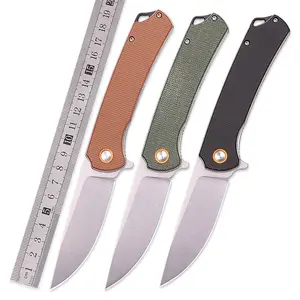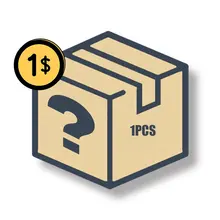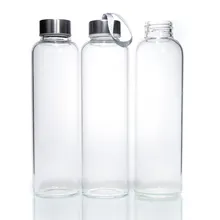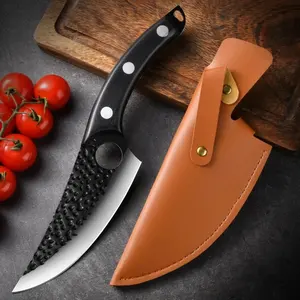Introduction
Whether you're a professional chef or a home cook, a boning knife is an essential tool in your kitchen arsenal. This guide aims to help you understand the intricacies of boning knives, their types, and their uses. We delve into the key features that make a good boning knife, the differences between Western and Japanese boning knives, and how to choose the right one for your needs. We also provide tips on where to find the best boning knife, be it online or at local kitchenware stores. This comprehensive guide is designed to equip you with the knowledge to make an informed decision when purchasing your next boning knife.
Understanding Boning Knives
Boning Knives are long, straight-edged, semi-flexible, and thin blades, usually between 5 to 7” long. They feature a flat cutting edge that curves slightly up to the tip. This unique shape helps to precisely separate meat from bones or joints with little waste. Boning Knives are designed for precisely removing meat from bones, cutting through connective tissue or ligaments, and separating meat from fat or joints. The blade is slightly flexible to allow you to maneuver in small spaces such as between bones, but it’s thicker and sturdier than a Fillet Knife.
Why a Quality Boning Knife Matters
The quality of a boning knife significantly impacts its performance and user experience. A top-quality boning knife offers a straight edge and a comfortable, grippy handle, making it easy to use. Its affordability is an added advantage. Key factors that determine a knife's quality include its flexibility, which aids in maneuvering around bones, the straightness of the blade, the handle design for comfort and safety, and the sharpness of the blade.
Key Features of a Good Boning Knife
A good Boning Knife is long, straight-edged, semi-flexible, and thin. Usually anywhere between 5 to 7” long, they commonly feature a flat cutting edge that curves slightly up to the tip. This unique shape helps to precisely separate meat from bones or joints with little waste. The blade is slightly flexible to allow you to maneuver in small spaces such as between bones, but it’s thicker and sturdier than a Fillet Knife. It's designed for precisely removing meat from bones, cutting through connective tissue or ligaments, and separating meat from fat or joints.
Types of Boning Knives
Boning knives come in different types, primarily categorized by the stiffness of their blades and their applications. Stiff boning knives are ideal for thicker cuts of beef, pork, and saltwater fish, as they efficiently separate bones from meat and remove fat and connective tissue. They typically have larger, straight blades ranging from 16.5cm to 22.5cm. On the other hand, flexible boning knives are perfect for tender cuts and delicate work like deboning and removing skin from fish and poultry. They usually have smaller, curved blades measuring between 12.5cm and 16.5cm.
Flexible vs. Stiff Boning Knives
Greater flexibility in a boning knife is beneficial for maneuvering around bones, making these knives ideal for tasks that require precision. However, it's important to note that the choice between a flexible and stiff boning knife depends on your specific needs and cooking style.
Western vs. Japanese Boning Knives
Boning knives, both Western and Japanese, serve similar purposes but have key differences. Western boning knives typically have a curved, flexible stainless steel blade, making them versatile for delicate work like deboning, skinning, and filleting. On the other hand, Japanese Honesuki knives have a triangular, thicker carbon steel blade, ideal for breaking down poultry. While Honesuki knives excel at preparing chicken, Western boning knives can work with diverse cuts of meat. These differences in shape, blade material, and thickness dictate their intended uses and performance.
Finding the Best Boning Knife
Looking for the best boning knife? Alibaba offers a wide range of boning knives from renowned brands. Prices range from $30 to $150, catering to different budgets. You can choose from various blade lengths, styles, and materials. Notably, the knives come with features like chip resistance, comfort grip handles, and are dishwasher safe. A good boning knife can make a significant difference in your cooking experience.
Local Kitchenware Stores
Finding a quality boning knife can be as simple as visiting your local kitchenware store. Many customers have found success with stores that not only offer a wide selection of boning knives but also provide excellent customer service. Quick delivery, informative product descriptions, and responsive customer service are some of the highlights of their service.
Online Retailers
Online retailers like Alibaba offer a wide range of boning knives. These knives are praised for their sturdy construction, pointed tips, and varying degrees of flex. Customers appreciate the quick delivery, excellent customer service, and the vast selection of knives. So, whether you're a culinary professional or a home cook, you're sure to find the perfect boning knife for your kitchen.
Culinary Schools and Specialty Shops
Culinary schools and specialty shops are often the go-to places for professional-grade kitchen tools. They offer a wide selection of knives, making it a favorite among culinary professionals. Their product descriptions are accurate, ensuring you get exactly what you ordered. Moreover, they are known for their competitive prices and superior customer service, making them a reliable source for your kitchen needs.
How to Choose the Right Boning Knife
Choosing the right boning knife involves several factors. Greater flexibility is beneficial for maneuvering around bones, while straight blades are generally easier to use. The handle design is crucial for comfort and safety during use. A sharper knife is always better, providing clean cuts and reducing the effort needed.
Consider Your Cooking Style
The type of boning knife you use will largely depend on your cooking style and the type of meat you handle. For thicker cuts of beef, pork, and saltwater fish, a stiff boning knife with a larger blade (16.5cm - 22.5cm) is ideal. It separates bones from meat and removes fat and connective tissue. For tender cuts and delicate work like deboning and removing skin from fish and poultry, a flexible boning knife with a smaller blade (12.5cm - 16.5cm) is more suitable. Your cooking style and the meat you frequently handle should guide your choice of a boning knife.
Evaluate the Knife's Quality
When evaluating the quality of a boning knife, consider factors such as flexibility, blade design, and handle comfort. A sharper knife is always better, and a comfortable handle design is crucial for safety.
Check Reviews and Ratings
When choosing a boning knife, it's always a good idea to check reviews and ratings. This can provide insight into the knife's performance and quality, helping you make an informed decision.
Conclusion
In conclusion, a boning knife is a crucial tool for any kitchen, offering precision and efficiency in separating meat from bones. The quality of a boning knife significantly impacts its performance, with factors such as flexibility, blade design, and handle comfort playing key roles. The choice between a flexible and stiff boning knife, or a Western and Japanese boning knife, largely depends on your cooking style and the type of meat you frequently handle. Whether you're shopping online or at a local kitchenware store, it's important to consider these factors and check reviews and ratings to ensure you're choosing the best boning knife for your needs. Remember, a good boning knife can significantly enhance your cooking experience.






































 浙公网安备 33010002000092号
浙公网安备 33010002000092号 浙B2-20120091-4
浙B2-20120091-4